The Bagpipe Society
Settala’s Sordellina: Steps in Reconstruction
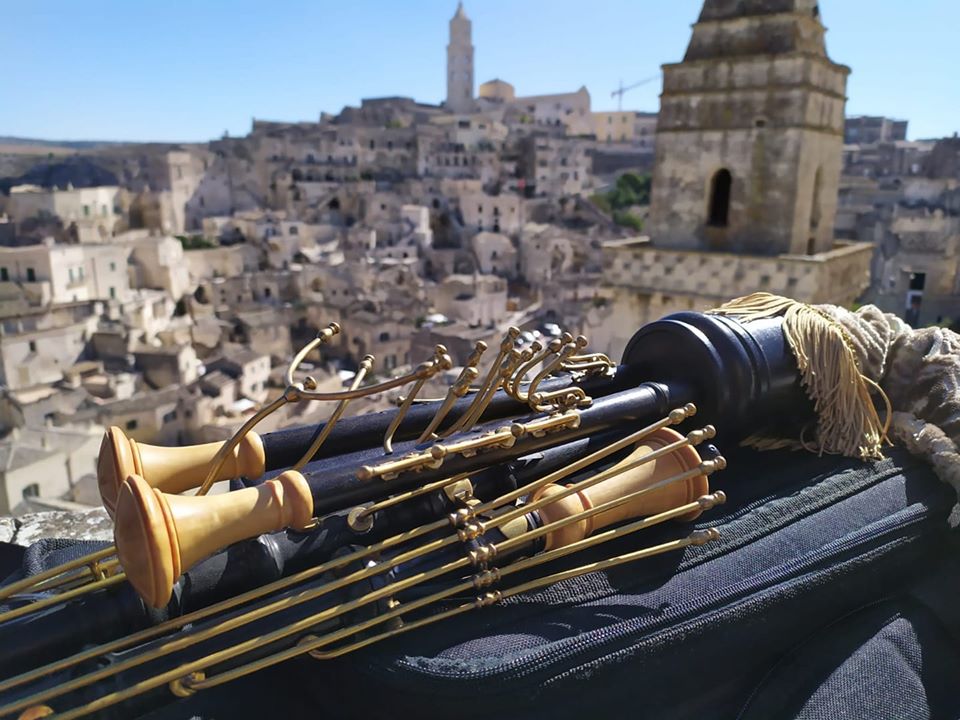
You may remember that the sourdeline, or sordellina in Italian, is a scholarly bagpipe, with bellows, equipped with two, three or four chanters, invented and played in Italy between the 16th and the 17th century. This fantastic bagpipe has been the subject of several recent studies and proposals for its reconstruction. Here is the account of our research, construction and bringing back to life the sordellina inspired by Manfredo Settala1 (1600-1680, Milano).
Reconstructing a lost instrument: the notion of authenticity.
What is the part of interpretation when it comes to restoring an object from the past? How does interpretation take the place of reality? The question has been asked several times, since the taste and the need for historical interpretation of ancient instruments has evolved over the last decades: “informed” baroque music or “medieval” music have imposed, to varying degrees, a reflection on the subject. “Authentic” organology, which we admit to be restitutions dictated by our knowledge, our memory but also our contemporary tastes, which very quickly impose a truth. It’s the Jurassic Park effect: Spielberg’s dinosaurs have become more real than their skeletons. But to create his prehistoric animals, Spielberg called on the most advanced knowledge of paleontologists in order to transform them into poetic objects. Are we the Spielberg of the sourdeline? To reconstruct a sourdeline it was necessary to combine science and utopia, history and poetry, sources and interpretation.
Reconstructing the sourdeline, a concerted effort.
It was when Marco and I met, 5 years ago, that we first dreamt of reconstructing the sourdeline. Marco is a famous zampogna maker and player, an engineer, whose grandfather played zampogna gigante in Lazio, north of Naples. He is also a great connoisseur of Italian bagpipes. And as an organist, he knows harmony perfectly. He has long experimented with making polyphonic keyed bagpipes, such as the zampogna a chiave, made 10 years ago. Reconstructing the historical sourdeline is therefore the fruit of our collaboration - a project that Jean-Christophe Maillard and I were already talking about, a long time ago, and J-C would have loved the outcome2.
The result is this perfect musical instrument, which we can guarantee resembles Langlois’s or Settala’s instrument, but cannot be the same as Settala’s or Langlois’s instrument.
Once these provisos have been accepted, we can move forward in the presentation of the “sourdeline by Tomassi”, and propose some theoretical views, in particular the link with the birth of the musette à deux chalumeaux, created by Martin Hotteterre around 1660.
Sourdeline(s) – Sordellin(e)
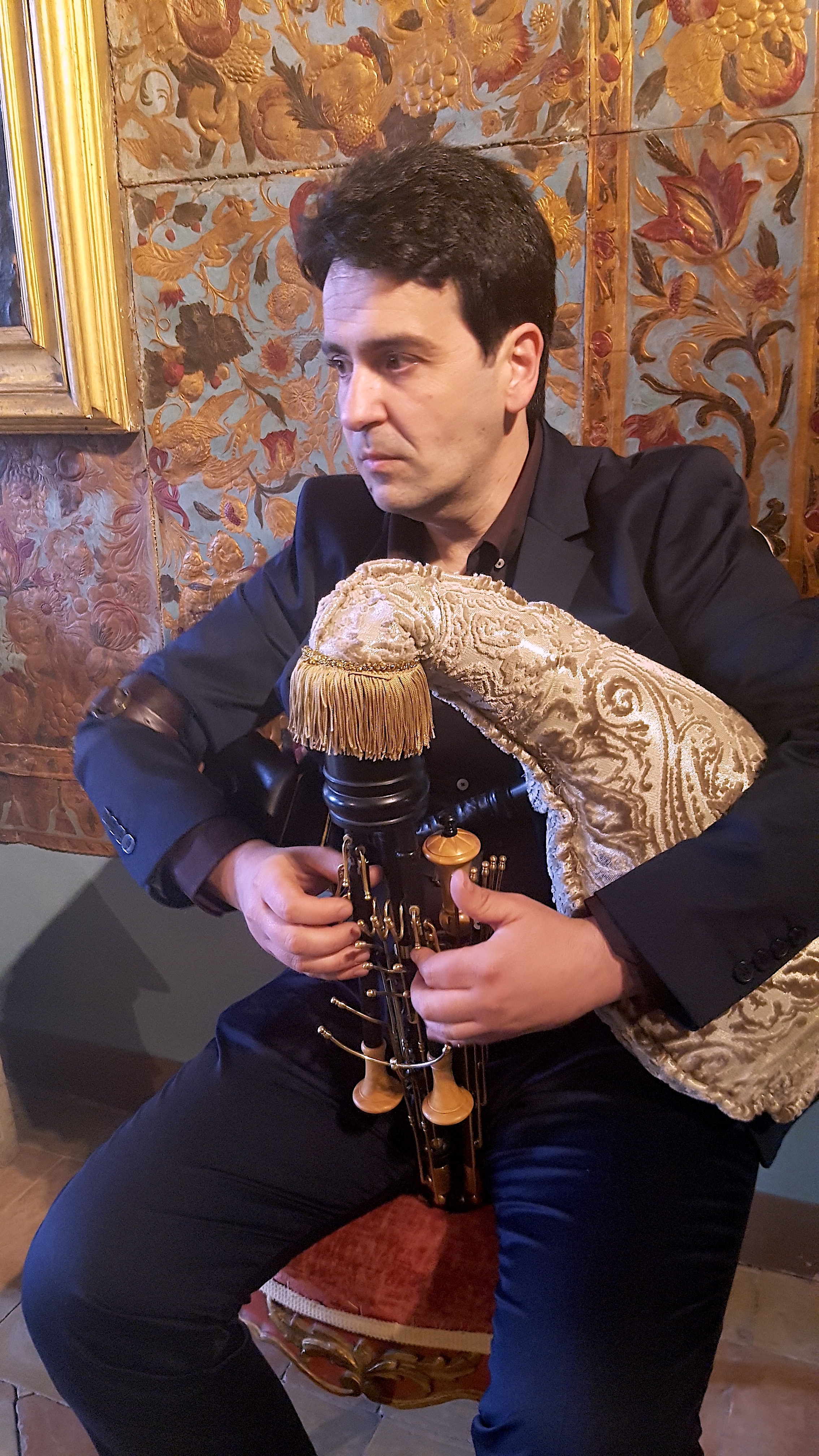
Reconstructing the sourdeline required relying on reliable sources and not on vague, ill-informed representations, especially as we do not have any surviving sourdeline, or even parts of the instrument. This is despite unconfirmed information about parts of the sordellina which survived the American bombing of the Naples Museum in 1943. Since the critical work of Van der Meer (1995) and O’Neill (2002), some important portraits have been found and published, giving us a better knowledge of this forgotten bagpipe. And a “harmonic flute” kept at the Bologna Museum bears the mark of the maker Settala. We will see its possible importance later.
The word “sordellina” undoubtedly refers to a number different 16th and 17th century Italian bagpipes: dependent on places and dialects, dependent on local customs, all sordelline were not one and the same instrument. That of Baldano in 1600, in Genoa, was certainly not that of Mersenne in 1636, nor that of Settala in 1640. But by a chrono-centered historical shortcut, our conception of the baroque sordellina is a combined vision, modern, contemporary and informed by our accumulated knowledge.
The most accurate information we have is provided by the exceptional iconography in four well known paintings: the two portraits of Langlois, (that we call here “Langlois 1” and Langlois 2”), the portrait of Settala by Nuvolone3, and the drawing published by Marin Mersenne4 in 1636. And again, we must note that the sourdelines represented by each artist are different. Mersenne offers his own view of the sourdeline: his description shows a modified sourdeline, to which he added an additional pipe on the basis of information collected in Italy by Gabriel Naudé, together with a bag “à la française” (which means round, and not long as in an Italian one). So, the name “sordellina” (plural sordelline) referred to different and successive organological types, and used in various regions. Linguistic homogeneity did not yet exist in 17th-century Italy, neither in France. For example, our generic terms for the “little goat” for the various Oc-language bagpipes - chabreta, cabreta, chevrette, craba, chabra, etc.… - correspond to very different instruments, and whose organology not has ceased to evolve during modern times5. The same was true of the sordelline; that’s why it’s better to talk about sourdelines in the plural.
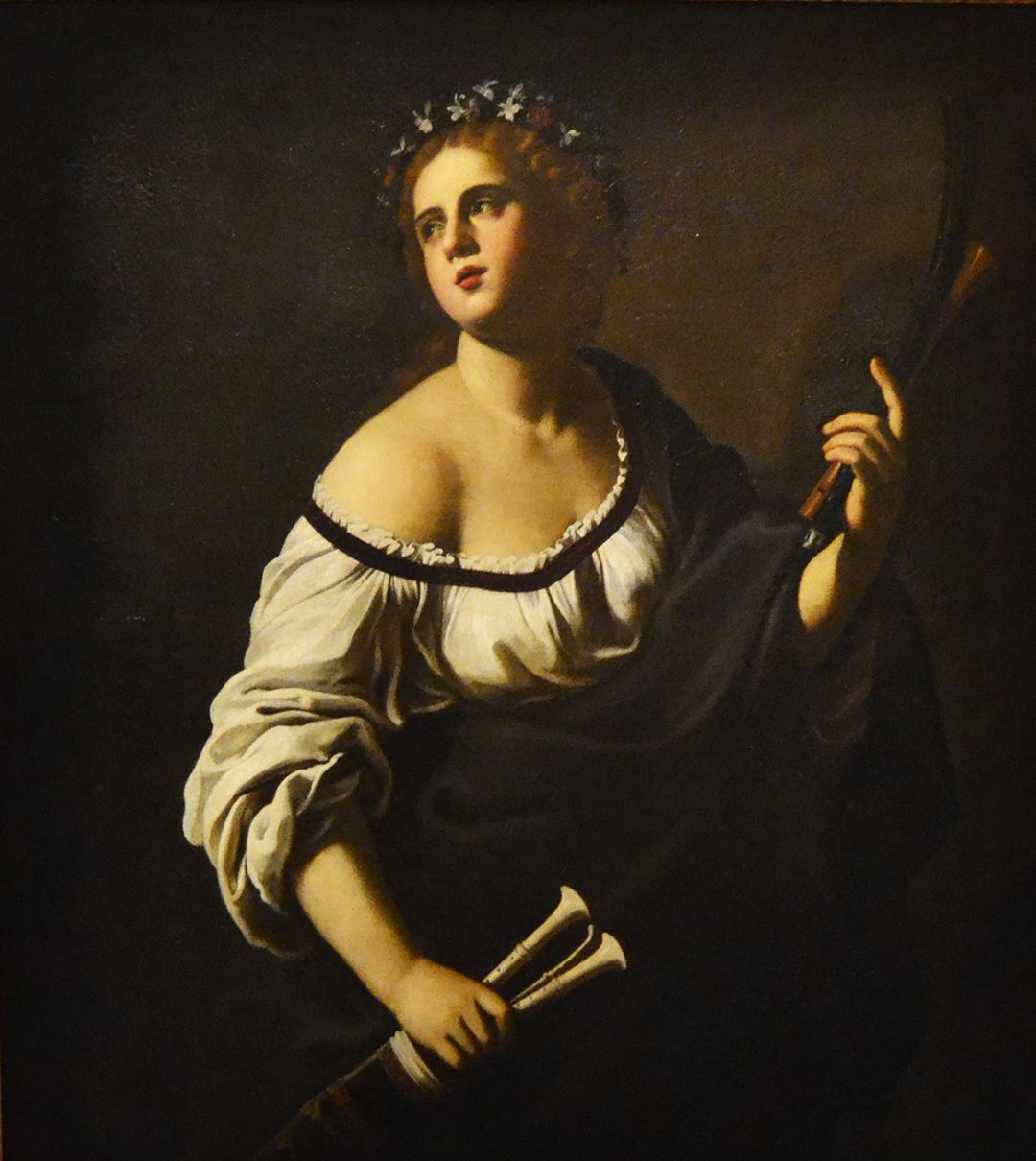
The first bi-melodic sourdeline date from the end of the 1500s, such as the one Baldano played in Savona and which Van der Meer and Tarrini studied in 1995. It is probably this type of sordellina that can be seen in two paintings, those of Gramatica (fig. 2) and Paolini (fig. 3). It’s a very simple model, with two melodic chanters and a medium pipe, probably a drone, the same length as the other two. It should be noted in Paolini6 the presence of a luth and a score, which refers to a written music.
In the Euterpe by Gramatica7, painted about 1620, (which originally faced a representation of Polymnia) the design of the ivory sordellina is quite simple and undoubtedly refers to a representation of the ancient aulos / tibiae. It is interesting to note that one of the inventories of that time uses the French word “musetta” to refer to this instrument8.
A rendition of this “original” sordellina model was made in 1996 by German musician and maker Horst Grimm, in a very convincing version of his interpretation of Baldano’s repertoire. But Baldano’s sourdeline, with two melodic chanters and a drone pipe was a simpler version than the one we talk about here. Besides, it’s not certain that Baldano’s sordellina was a bellows-powered bagpipe, as Van der Meer remarked. Anyway, the German maker, Horst Grimm, produced a remarkably musical and enjoyable record. He was the first to reconstruct a sourdeline and to record Baldano’s repertoire9.

The sourdeline underwent an organological evolution over a century (1560-1660?), from a model with two melodic chanters with drones, to models with three melodic chanters without drones, and then four melodic chanters as developed by Orsini (Duke of Bracciano) to Rome, then Settala in Milan.10 Our iconographic or written sources focus on a more complex model, the one played by Langlois and Settala, and described by Mersenne, Trichet, Scarabelli and Terzago, or Todini.
That being said, we will concentrate on the three-pipe melodic sourdeline in use in the period 1630-1660 in Italy.
The sordellina with three and four chanters: Our iconographic sources
We have various iconographic sources which show varying levels of detail: two portraits of François Langlois (fig. 4 and 5) c.1620 and 1635, the drawing by Naudé (?) for Marin Mersenne (1636, fig. 6), the portrait of Settala by Nuvolone (ca 1640, fig. 7) and finally the drawings by Fiori at the death of Settala, in 1680 (fig.8).
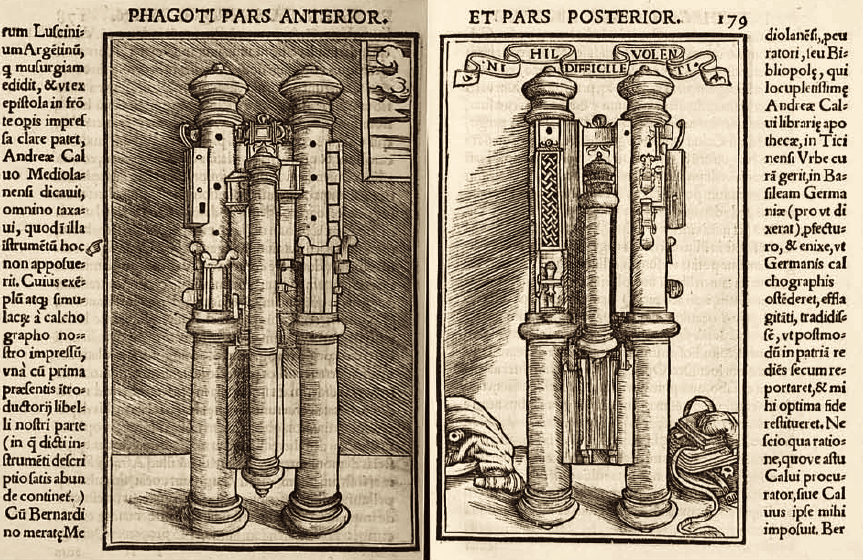
We have other iconographic sources11: an anonymous painting preserved in Sessa Aurunca, painted around 1640 (fig. 9). A fresco by Daniele Crespi, in the Chartreuse of Pavia12. And then the three-dimensional representation of the sourdeline played by the automaton Polyphemus, by Todini (circa 1650), kept at the MET in New York (fig. 10).

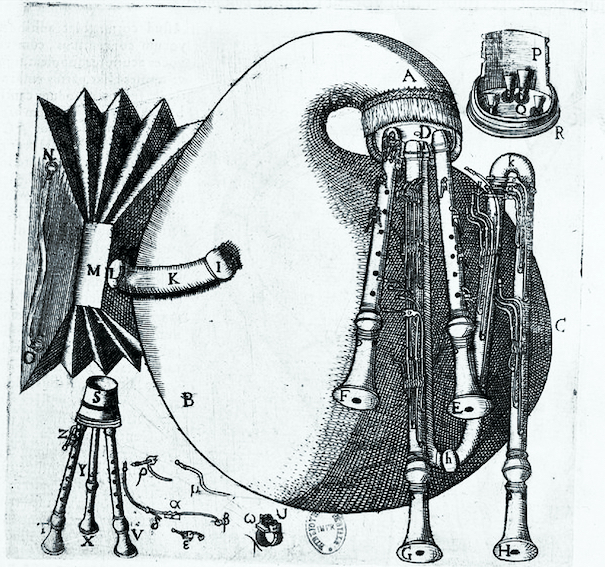

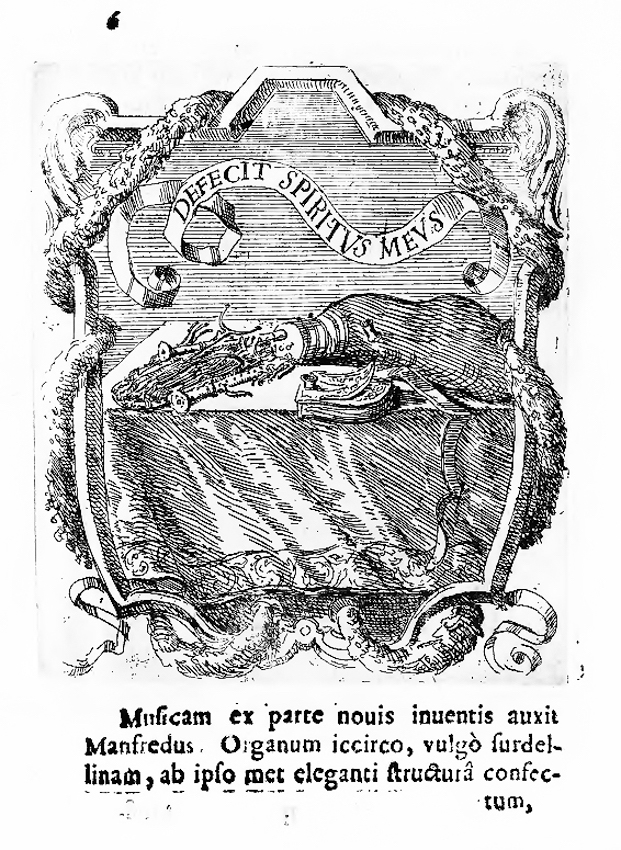

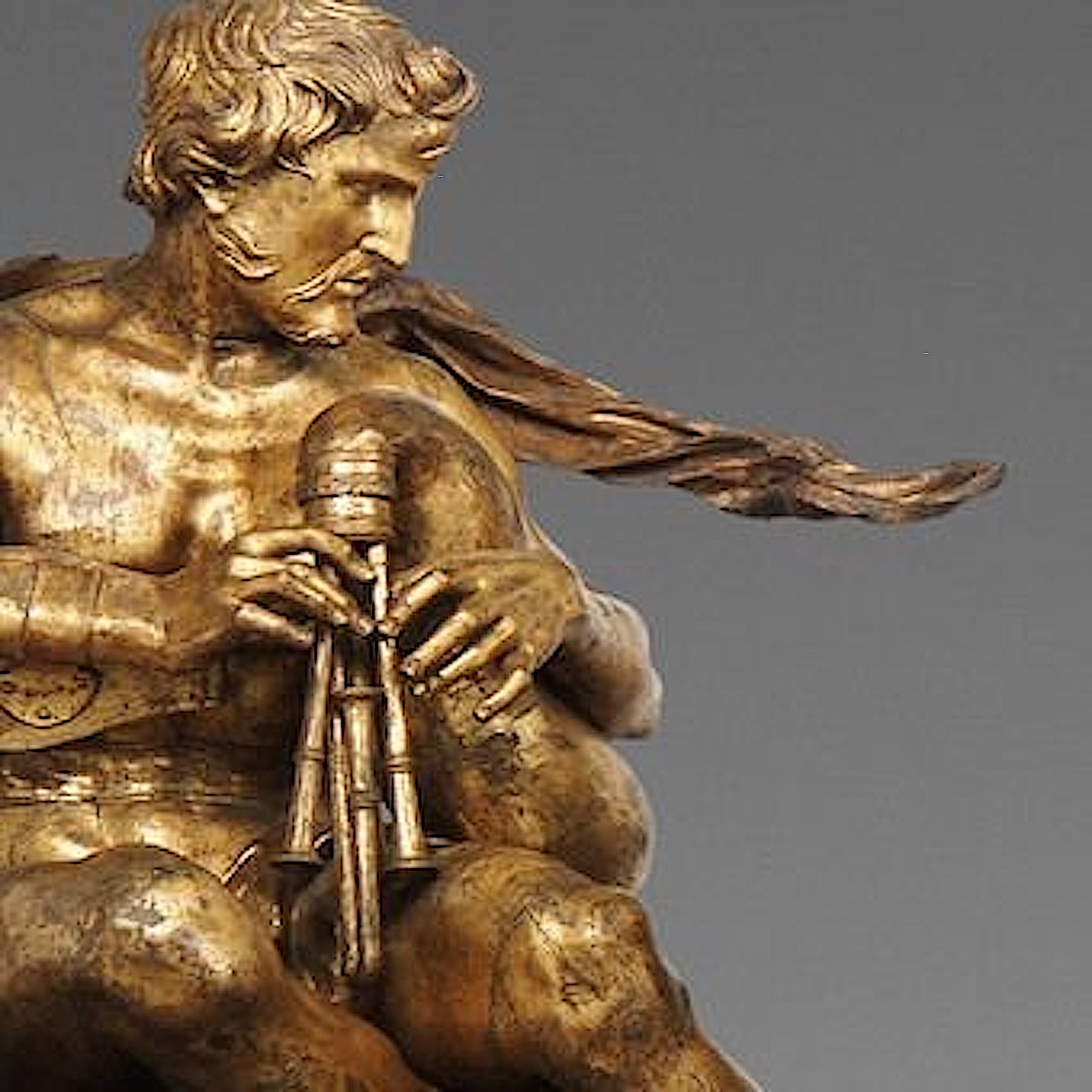
The various paintings representing François Langlois (1589-1647).
François Langlois, active in the years 1600-1630 in France and in Europe, established himself as the earliest master and, above all, one of the most famous players of sourdeline and musette. The figure of this artist, who was equally a designer, musician, art dealer, diplomat, is particularly representative of the pastoral and Arcadian fashion which touched European intellectuals and, in particular, the French, in the 17th century. It should not be forgotten that this Arcadian fashion came from Italy, particularly Florence. The sourdeline was an Arcadian bagpipe, played by artists, poets, sculptors, painters or comedians, in the 1600s in Italy.
François Langlois appears as a whimsical character, socialising with painters, engravers and social aristocrats. We can easily imagine him as a free travelling man, reveler and joker. Langlois can be found between 1614 and 1621 in Rome, Genoa, Florence, Milan, Naples, and again in Rome and Naples in 1633: in all these places traces of sourdeline can be found, as confirmed by Leydi, Van der Meer or Tarrini.
Langlois was an art dealer in London around 1630, working with the greats of the English Court, and finally in Paris, where he settled permanently from 1633 until his death.
In Rome Langlois also frequented with the painter Claude Vignon, who painted his portrait around 1621. It was undoubtedly there that Langlois was introduced to the sourdeline. He was about 30 years old and he would then show this instrument throughout Europe. We know that he played in Bordeaux, France in 1626, where the collector Trichet came to see him and described the details of his instrument in his diary13.
In two portraits of Langlois (fig. 4 and 5) we can clearly see the two melodic chanters, with gilded ferrules and mounts, and certain keys, including the characteristic “Y” double key. His sourdeline is played with bellows. Langlois returned to London in 1635-37: it was on this date that we see him posing in front of his desk. Among the various objects is the sourdeline. As this painting is now kept in Paris, I was able to observe it and take very precise pictures (Langlois 2). Here the instrument is represented in an almost photographic way, in close-up: the massive stock with a gilded band, the contrebass pipe which is open at the end, its keys and their positions, including the famous key in spectacular Y, and the left-hand chanter with its keys, seen from behind. On the table there are also three flutes and a score, which provides information on the association of the instrument with written music.
A year later, in 1636, Mersenne published in his “Harmonie Universelle” a detailed description of the sourdeline with a drawing (fig.6), which, until now, had remained the most reliable source on this fascinating instrument. This drawing made the sourdeline famous, as much by the text of Mersenne as by the apparent complexity of this curious bagpipe, sometimes compared to a giant spider. We know from the correspondence of Marin Mersenne that he sent to one of his contacts in Italy, Gabriel Naudé, a drawing of “cornemuse” in order to find more information.14. It is worth noting that Mersenne was a correspondent and a colleague of Pierre Trichet, who admired Langlois and his sourdeline in Bordeaux ten years earlier in 1626. Naudé was a personal friend of the great Milanese doctor Ludovico Settala, father of Manfredo, who founded the remarkable museum15.
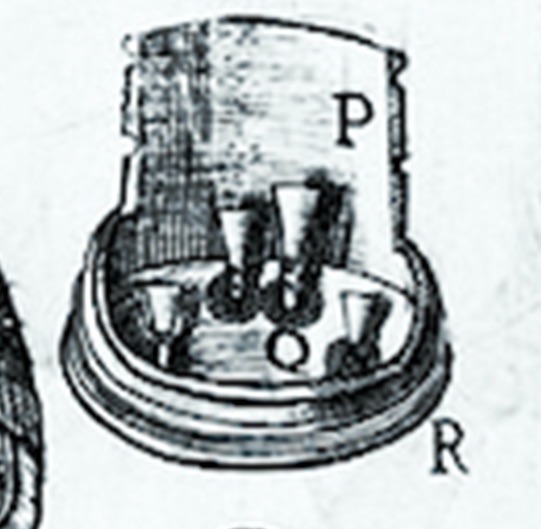
The information given by Mersenne in Harmonie Universelle, either his own or that given by Trichet, is numerous and essential. We see the four double reeds (fig. 11), associated with the four melodic chanters, as well as the details of the keys and their distribution. Mersenne also details the various keys used on the chanters, with very precise drawings. But the sourdeline of Mersenne can’t be considered as an objective source of information, as he says himself: he added a fourth pipe16. However, this drawing is an interpretation, since Mersenne admits that there appeared an “improved” sourdeline, equipped with a fourth chanter such as that developed by the “Duke of Bracciano” Paolo Orsini17, but he had not actually seen it:. He also, on his own initiative, showed the sourdeline with a round bag, “à la française”, unlike the elongated bag of the Italian model.
It was also on this occasion that Mersenne encouraged the French musette makers to draw inspiration from the complex polyphony of the sourdeline, a lesson Martin Hotteterre would follow some thirty years later.
Mersenne attributes the invention of the sourdeline to a certain Jean-Baptiste Riva of Ferrara in association with “Dom Julio and Vicenze”. These are unknown figures, one of which is a priest. Riva of Ferrara (“Rivalius”), is quoted too by Mersenne as the inventor of the phagotum. If the information is correct, the sourdeline would indeed have been developed as early as the middle of the 16th century, logically an evolution of the phagotum of Afranio of Ferrara18.
It was also around this time that Van Dyck painted his famous portrait of Langlois as a French musette player. It is interesting to see that Langlois plays the musette as the sourdeline, his right hand positioned at the top of the chalumeau. Perhaps Langlois played the sourdeline before the French musette?
Let us return to Manfredo Settala (1600-1680), who will be our next source, chronologically, in the period between 1640 and 1646. In the Settala Museum, from the 1640s, one could see all kinds of objects: a stuffed crocodile, an Amazonian Indian adornment, astronomical measuring instruments, paintings by the greatest painters of the time (like Leonardo da Vinci) as well as a series of bagpipes of his own making, sourdelines, which were made from horn or ebony. The contents of this museum can be found in two catalogues by Terzago and Scarabelli,, one in Latin, the other in Italian. The description shows how much care Settala took in the making of his sourdelines, one of which is described as having 56 silver keys19. There is an engraving of this museum, but having looked carefully, I cannot see the sourdelines depicted. (fig.13). Likewise, in the “book of secrets” that Settala commissioned, there are some magnificent colour drawings showing his collection, but only five codexes20 survive, out of the original seven. Mersenne does not quote Settala, this inventor-traveller, who is still our principal source for the three-pipe sourdeline. However, everything leads us to believe that the sourdeline published by Mersenne is linked to an instrument by Settala.
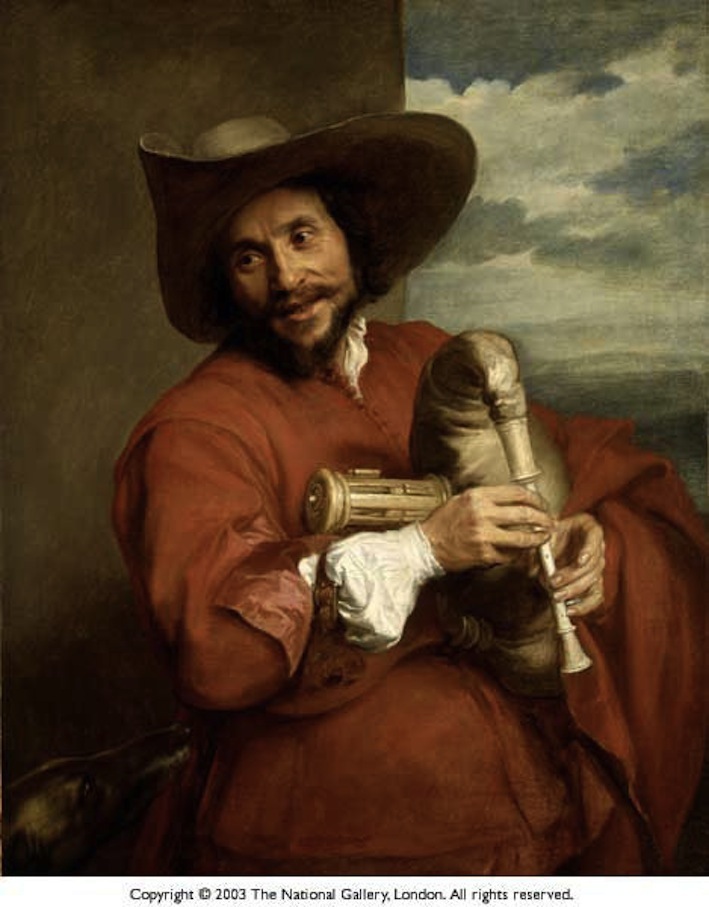
I discovered the original portrait of Settala (fig.7) (which had previously only survived as a poorly reproduced print21), and I published it 3 years ago, thanks to the support given to me by Professor Morandotti of the University of Bologna, an expert in the work of the artist, Nuvolone22. Until then, we just had one photo of this painting, and its whereabouts were unknown.
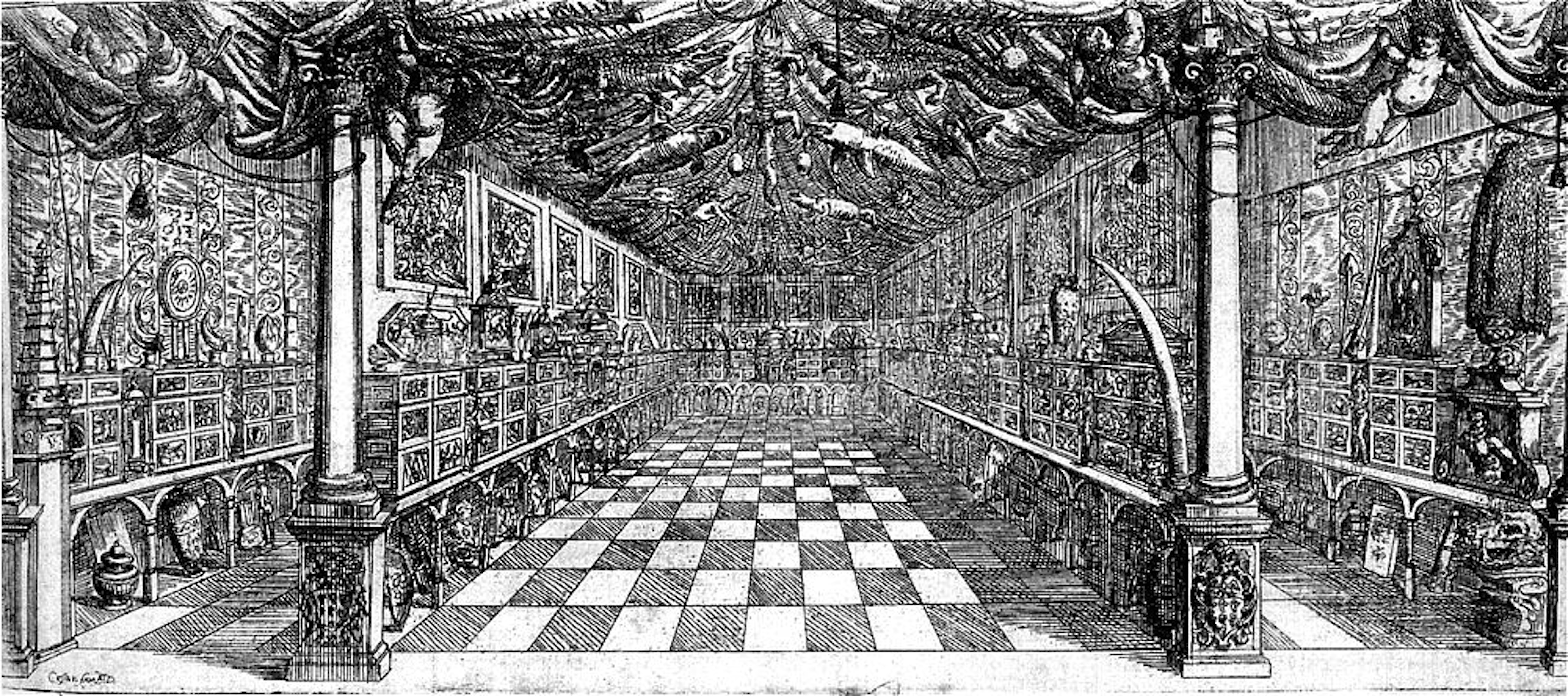
In this painting, the sourdeline is shown front facing, as in Mersenne’s drawing, to such an extent that I wondered if there was not a link between the two representations, one inspired by the other. Does Nuvolone’s painting (1640) reproduce somehow the engraving of the Harmonie Universelle (1636)? We know that Settala was aware of Mersenne’s publication and his writings on the sourdeline, since his museum’s catalog, published in 1666 and 1677, quotes several times from the Harmonie Universelle23. (Fig. 14)
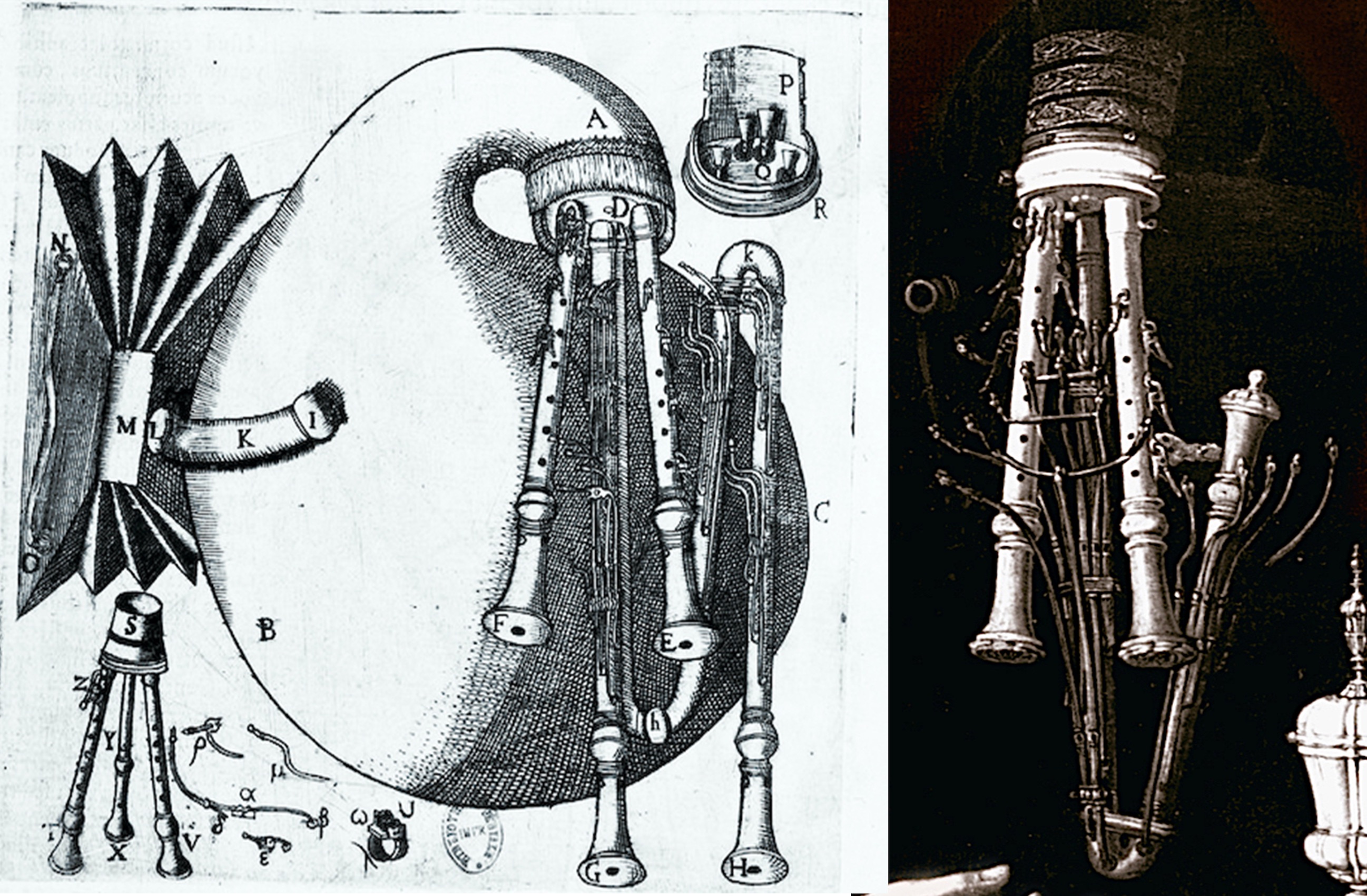
In Settala’s portrait the set of keys and their position on the three chanters is very realistic, and it also offers a very precise view of the instrument’s bellows, covered with scales (snake or crocodile skin).
An unknown sourdeline has now been added to our information, with the discovery two years ago by Marco of a beautiful painting, recently restored, in the chapel of the former convent of Sessa Arrunca, north of Naples (fig. 9). It shows a sourdeline player accompanied by a harp, a cornet and singers, gathered around a score, in a religious setting. The painting was attributed to the Neapolitan painter Paolo Domenico Finoglio (1590 - 1645). The performance adds little new to our knowledge of the instrument but confirms its use for the accompaniment of song in a sacred context.
This painting, probably around 1640, shows us an ebony sourdeline of the same type as that of Langlois. It has three melodic “chalumeaux” (chanters) bearing the same keys, including the famous Y for bass chanter giving a low Do# and played by the little finger of each hand. It is inflated by large black leather bellows.
In Todini’s Galeria Armonica24, a small book published 1676, there is an explanation of the making of a mechanical harpsichord, which also operates a sourdeline, played by an automat, the Cyclop Polyphemus (fig. 10). This object, now in the MET in New York, was undoubtedly designed around 1650. The study carried out by Winternitz25 and then by Stewart Pollens26, curators at the MET, failed to demonstrate the playability of this mechanical instrument. There remains the 3D figuration, which shows a sourdeline quite similar to that of Settala, and some information on the keys of the instrument, given by Todini himself in his text.
Other representations exist, but which have not provided decisive information for the restitution. For example, the sourdeline of Settala drawn for his funeral in 1680 (“Defecit Spiritus Meus”) by Fiori27(fig.8).
RECONSTRUCTION
The reconstruction of the sourdeline has been made based on the sources described here, but adapted taking into account playability of the instrument: experimenting with the fingerings, the position of the keys and their ease of articulation, the flexibility and balancing of the reeds. Theory cannot beat the step-by-step development of someone who is a maker as well as a player. All bagpipe players are aware of this inescapable fact.
The choice of pitch and temperament.

Todini specifies that the contrabass chalumeau gives us “the lowest note is the first note of the harpsichord”, that is to say an F28. The lowest note of the sourdeline is that given by the bottom note of the contrabass chanter. Marco therefore used this indication to establish the measure of the bass chanter. The lowest note is therefore a Fa2. It is also the lowest note of the drone of the musette kept at the Calvet Museum in Avignon29, which we have also observed and noted. This musette, undoubtedly one of the first with a double chanter, may possibly be by Hotteterre. In any case, it corresponds to the drawings of Borjon in his Traîté de la Musette30 of 1672. (Fig 15)
It was from this musette main chanter that we established the bore and pitch of the two main chanters of our interpretation of the sourdeline. We adopted unequal temperament as the scale, as used in the 17th century, especially on polyphonic reed instruments.

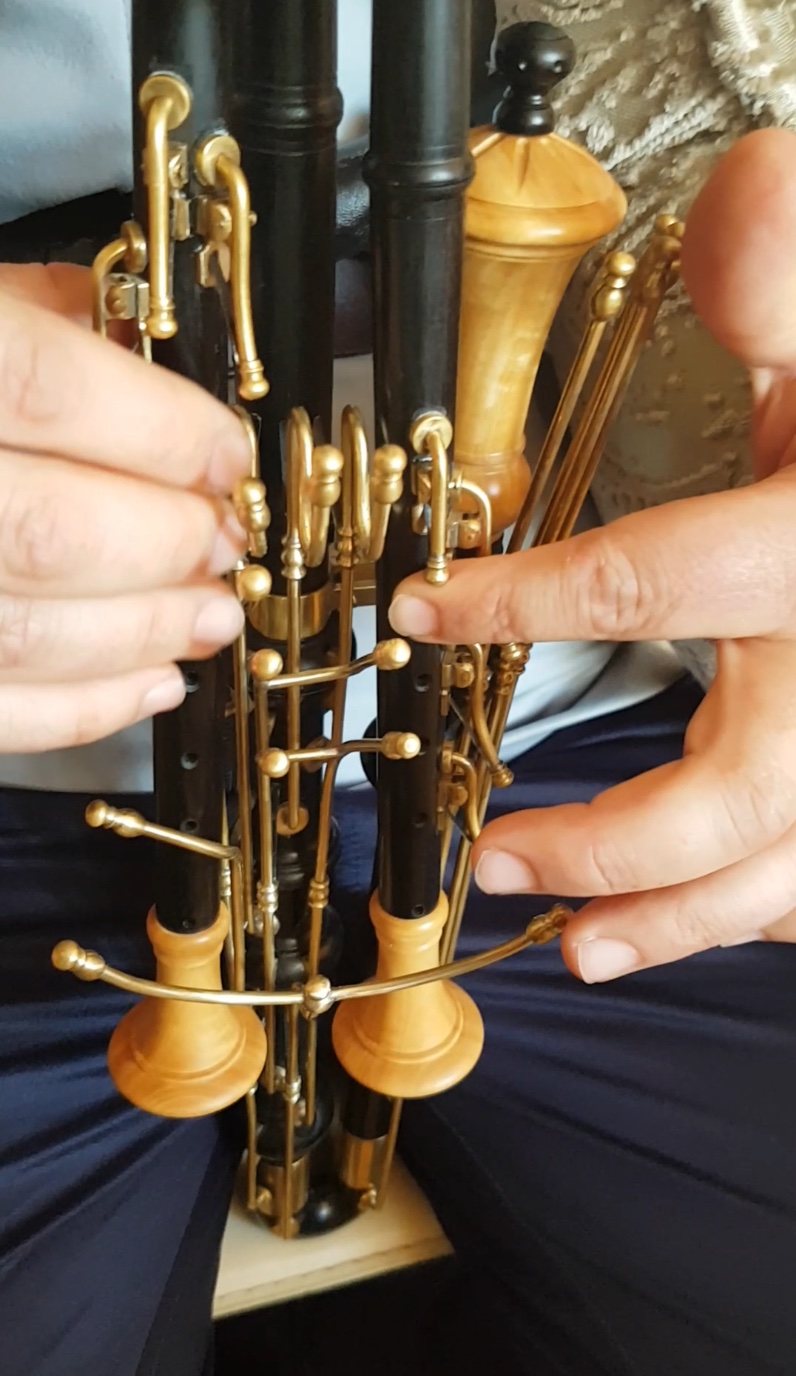
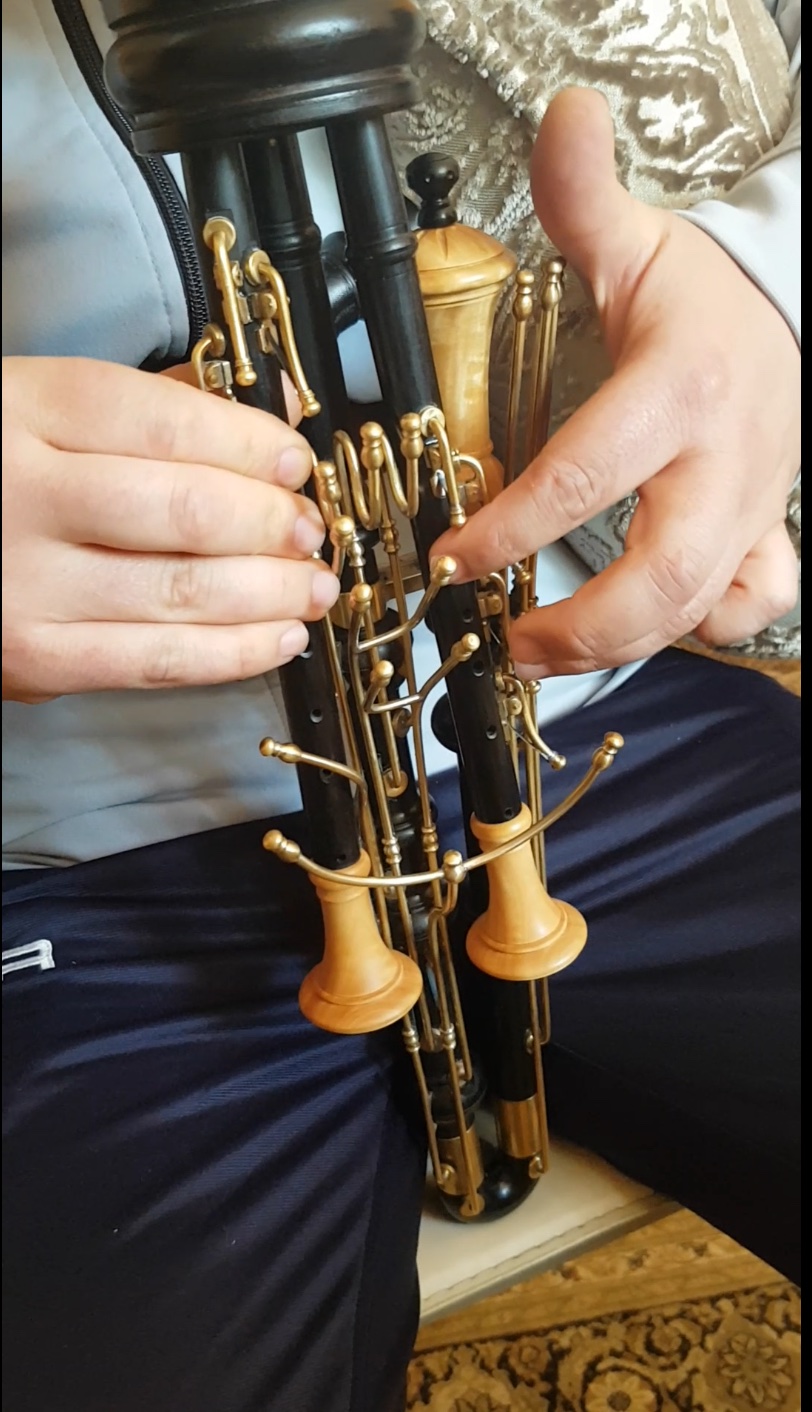
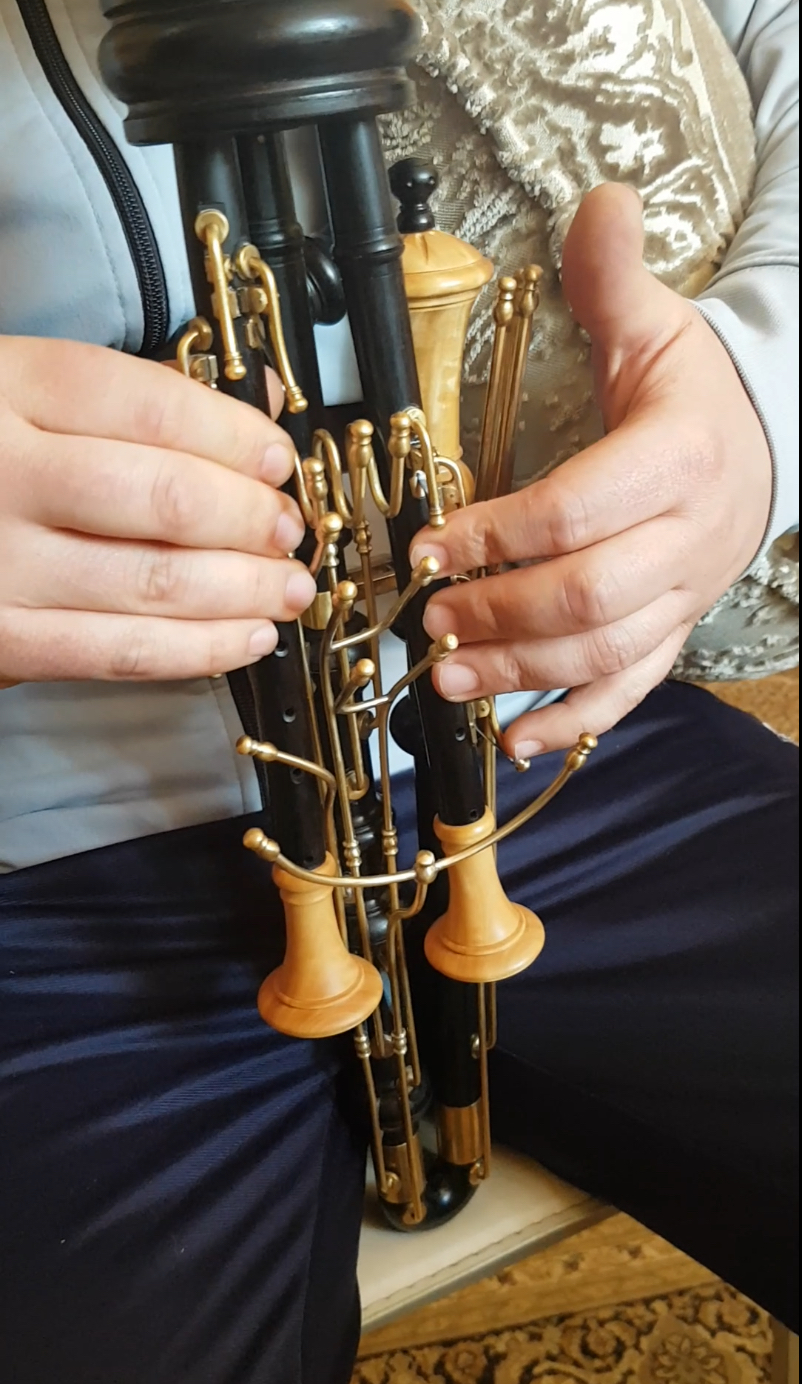
The three chanters and their keys Fig 16a,b,c & d, showing close up of keywork
The manufacture of the keys was made possible thanks to the drawings of Mersenne and their interpretations in the portraits of Langlois and Settala.
On the Mersenne sourdeline, the double-back bass chanter has keys fixed to the elbow/bend. The tenor pipe in the middle has keys along its length.

Most of the bass chanter keys are doubled, played either by the thumb or little finger. It should be noted that the keys of Mersenne’s sourdeline are not doubled, but only oriented to the right.
The brass rods are 3mm in diameter and they are fixed to the sides of the chanters. Their articulation is guided by bosses. This type of arrangement of the keys around the outside of the chanter can be seen on the “petit chalumeau” of the musette at the Musée Calvet d´Avignon: the keys are not laid out flat but around the circumference of the pipe; a characteristic that will disappear with the 18th century musettes, the keys being laid flat on the small chalumeau. (Fig 17) Perhaps, this was also borrowed from the sourdeline.
Range
From F2 (double bass) to F5 (right chanter): three full octaves and 23 keys.
The main pitches are F major and Bb major, and their minor relative pitches: G minor and C minor, but it is possible to modulate in limited tones, like on the harpsichord. The two right and left chanters are identical, only the positions of the holes change.

Right Chanter (left in the photos)
7 holes and 6 keys + 5 tone holes: 4 in front and 1 behind for the thumb. 5 holes are stopped by the fingers, 2 remain open. The thumbhole option seems logical enough, although Mersenne does not describe it and is not visible on the various paintings. However, the only surviving Settala instrument, a multiple “harmonic flute” (also called “zampogna” in his catalogue), has this thumb hole. It is now in the Bologna museum and was restored by Rainer Weber31.This organological information allows us to follow Settala’s example, in addition to Marin Mersenne’s text32.
From bottom to top, closed holes: Eb, F4, G, A, Bb, and C (open thumb) + 6 Keys from bottom to top: G#, B, D, Eb, E, + open thumb, F5. The highest note of this sourdeline is an F5.
Left Chanter (right in the photos)
5 holes, 4 play holes and 4 keys. No thumbhole.
From bottom to top, holes closed: C3, D, E, F4, and G all open + 4 keys from bottom to top: Eb, F#, A, Bb.
Contrebass chanter (middle)
1 hole, 14 keys.
From bottom to top: F2, G, G#, A, Bb, C, C #, D, Eb, E, F3, G, A, Bb.
Langlois’ sourdeline had an open contrabass, while Settala’s was closed. But there is a possibility of staccato or legato playing: On Settala’s, the top of the contrabass may be rotated (this was Marco’s option, stopping the sound). On Langlois’s, a key closes the pipe when required.
The mouldings on the chanters serve as guides and stoppers for the play of the keys and their articulation. The keys and their mechanisms (what Trichet called “ressorts") are made up of 200 different parts.
The reeds
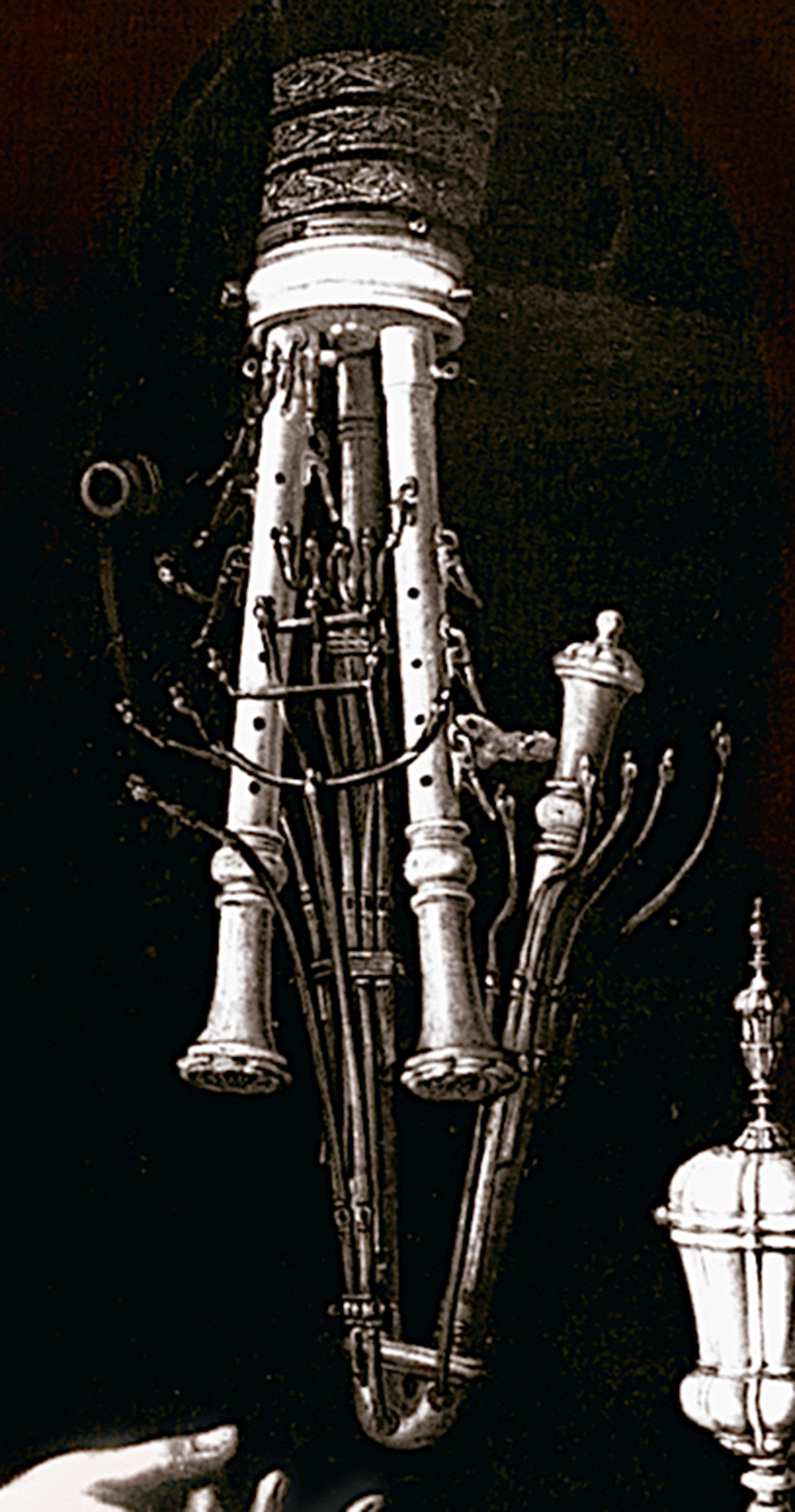
We know from Mersenne that they are double reeds with cylindrical barrels (fig. 10). This is the type of reed is still in use on Italian zampogne, it is also the type of reed used on French musettes.
The chanter pipe from the musette at the Musée Calvet served as a model for reproducing the chanters of the sourdeline: identical length, identical tone and a cylindrical bore. The surviving reeds from this musette were also used as a basis for the sourdeline reeds.
The materials
The different representations show sourdelines in ebony, ivory, with golden or silver keys. Terzago’s catalog specifies that Settala’s sourdelines are made of ivory, ebony and horn, boxwood, with silver keys. Marco’s choice is ebony, with gold plated keys covered.
The relationship to traditional zampogne.
The well-known sourdeline makers were Jean Baptiste Riva of Ferrara and the Duke of Brasciano in Rome (Orsini) after Mersenne, Manfredo Settala in Milan, Antonio Novelli in Florence, Michele Todini in Rome … so we see that they were artists and scholars from northern Italy, Tuscany or Campania: none is a Neapolitan (zampona) maker.
We are dealing with a phenomenon identical with that of the French musette: a parody of a popular instrument gives life to a scholarly instrument with a more complex organology than that of the popular bagpipes which inspired it. This phenomenon, also similar to that of the “vielle-à-roue” in 18th-century France, is part of the continuity of the Italian Arcadian movement for the French musette. Indeed, when Settala or Orsini developed their bagpipes with three or four polyphonic chanters, around 1630-1640, the French makers, including Hotteterre, still only produced a monodic bagpipe, with a cylindrical hole and a double reed, with its sophisticated “à-tous-jeux” drone. Borrowing from the polyphonic system, with two chanters, will only be realized around 1660 by Martin Hotteterre. Some rare 18th century musettes, a hundred years after Settala’s sourdeline33. experimented the three polyphonic bores, with two bores included in the “petit chalumeau”, one century Another borrowing from this Italian sophisticated bagpipe can be seen in some musettes which have closed chanter at the end, allowing the “staccato” playing as on the bass chanter of the sordellina34.
The sourdeline was inspired by zampogne “a paro” (in pairs) which have pipes of equal length, unlike the zampogna “zoppa” (“lame”) of unequal pipes. In the same way that the French musette was inspired by popular bagpipes to give a parodic version, and thus spawned new models of popular bagpipes in succession (musettes Béchonnet, cabrettes, small pipes, etc.), the sourdeline, inspired by traditional Neapolitan zampogne, gave a scholarly version, which was later perpetuated in particular in the giant zampogne of Lazio and Campania (Cassino), in the same pitch as the sourdeline (Fa), two octaves lower.
What is the sourdeline’s repertoire?
There is of course Baldono’s Libro… (1600) which provides the basis for a two-voice + drone polyphonic repertoire, the best pieces of which were recorded by Horst Grimm35 in 1996.
The search for an instrument capable of playing hymns, canticles, and matching the organ - not on a keyboard instrument but on an instrument similar to the ancient auloi and tibiae, was already present in the purpose of inventor and player of the phagotum, Afranio degli Albonesi of Ferrara, a century earlier. It is possible to see a continuity of the phagotum in the sordellina. The reference to auloi or tibiae is recurrent among the authors and composers of the time, the bagpipe in various forms being a symbolic continuity of the Arcadian auloi.
As an example, Cavalieri’s: “Io Piango Filli”. This aria is taken from the Rappresentazione di Anima, and di Corpo, by the Italian composer Emilio de Cavalieri (1550-1602). It is a sacred drama of an allegorical character, given in Rome in 1600, and is regarded as one of the first operas. In the preface to the work, the composer gives some notes to interpretation: it is a matter of bringing up to date the Platonic principles of wisdom and moderation against the temptation of the world, in a debate between soul and body. He summons “the old customs”, referring to the Ancients, Greeks and Romans, he states that “the song must be accompanied by two flutes or the ancient tibiae36” He recommends using copies to mimic the auloi, “because we have several in our time”. “Io piango Filli”, is based on a text by the Neapolitan poet Sanazarro, whose major work, “Arcadia”, is known to have influenced the entire Renaissance, and especially in France (La Pleiade, Ronsard, Baïf, etc.). Cavallieri indicates in the score in three voices that accompanies the text of the “Io Piango Filli”: “Due Flauto, o vero sordelline”. The Cyclopeus Polyphème of Todini is a reference to Antiquity and mythology. For Baldinucci, Novelli played a sordellina “like that kind of flute whose breath came from a bag, and which the Greeks called ascaulos37”. There are many examples of this kind of references to ancient aulos or tibiae.
We can clearly see the allegorical meaning given to the instrument; it is also an indication of the use of the sourdeline to accompany the song, and its use on the opera stage.
To see the sordellina online :
https://www.facebook.com/eric.montbel/videos/389356365000296 https://www.facebook.com/eric.montbel/videos/2717189214999161 https://www.liuteriamontecassino.com/ https://www.ericmontbel.com/iconographie-de-la-sourdeline
Marco is already preparing a CD of sordellina with friends, that will be produced in 2021 by Finisterre. http://www.finisterre.it/la-sordellina/
Eric and Marco will present a conference and small concert in Le Son Continu, festival of Central France in Ars, the 18th of July 2021.
References
- Already published in Chanter our study about the rediscovering of the original portrait of Settala by Nuvolone : MONTBEL Eric, “The Sourdeline of Manfredo Settala, a Milanese inventor in 1640. Part 1”, Chanter, The journal of the Bagpipe Society Magazine, Summer 2015, p. 16-22. “Part 2”, Autumn 2015, p. 15-23. MONTBEL Eric, “Le portrait de Manfredo Settala attribué à Carlo Francesco Nuvolone: un hommage au collectionneur et facteur de sourdelines”, in Musique-Images-Instruments n° 15, Portraits, ballets, traités, CNRS Editions, 2015. For earlier sordellina studies, see: Febo GUIZZI and Roberto LEYDI, Le zampogne in Italia, Milan, 1985. John Henry VAN DER MEER, Maurizio TARRINI, “La Sordelina: organologia e tecnica esecutiva” in Giovanni Lorenzo BALDANO, Libro Per Scriver L’Intavolatura per Sonare sopra le Sordelline. Savona, 1600, facsimile, published by Associazione Ligure per la Ricerca delle Fonti Musicali, Savona, 1995. Franck P. BÄR, “Le Museo Settala à Milan au XVIIe siècle: une collection d’instruments de musique à l’esprit français”, Musique-Images-Instruments, 2, 1996, p. 58-87 Barry O’NEILL, “The Sordellina, a Possible Origin of the Irish Regulators”. The Seán Reid Society Journal. Volume 2. March 2002. Laurence LIBIN, “Claude Vignon’s portraits of François Langlois”, Musique-Images-Instruments, 5, 2003, p. 159-166.
- Jean-Christophe MAILLARD, “Variations et innovations dans la facture de la musette au milieu du XVIIIe siècle” in Musique-Images-Instruments, Revue française d’organologie et d’iconographie musicale, N°4, Nouveaux timbres, nouvelles sensibilités au XVIIIe siècle (2e partie), CNRS, Paris, 1999, p. 54-69.
- First published in a black and white version by Alessandro MORANDOTTI, “Note brevi per Cerano animalista, Vermiglio pittore di figura e Carlo Francesco Nuvolone autore di ritratti”, Il Seicento lombardo: giornata di studi, Mina Gregori (ed.), Turin, Artema Compagnia di belle arti, 1996, p. 68-69, fig. 107. And F.M. FERRO, Nuvolone. Una famiglia di pittori nella Milano del ‘600, Soncino editore, 2003, p. 415 (photo), p. 194.
- Marin MERSENNE, Harmonie universelle contenant la théorie et la pratique de la musique, Paris, 1636. Édition en facsimile avec introduction de François Lesure, Paris, Editions du CNRS, 1986. p. 293-294.
- Note, for example, that today there is a bagpipe in Calabria called ‘surdulina’. It’s a cylindrical drill ‘a paro’ zampogna, with the left pipe stopped, allowing for staccato playing. It’s hard to say that this example pre-dates scholar sordelline, or whether this is a local name more recently attributed. We all know in France the adventures of the word “musette”. See Nada GITTO. “Surdulina: A little bagpipe of Balkan origins, built in the USA and returned to Italy. Musical performance, Organology and analysis of repertory”. International Bagpipe Conference, online, 6th of June 2020.
- Pietro PAOLINI (1603-1680), Suonatore de sordellina, ca 1625. Priv. Col.
- Antiveduto GRAMATICA (1571-1626), Euterpe, ca 1620. Galleria Sabauda, Torino.
- “L’inventario successivo, del 1682, … descri ve con dovizia di particolari le singole Muse e la descrizione di Euterpe sembra corrispondere appieno al nostro dipinto: « Musa coronata di fiori con una Musetta da una mano, ed una cornetta, e fragioletto dall’altra, pure dell’Antiveduti con cornice indorata”. Cristina SANTARELLI : le collezioni dinastiche dei duchi di savoia nel seicento: problemi di iconografia musicale. Biblioteca Musicale LIM – Saggi, 2001.
- Horst et Barbara GRIMM, Il libro delle sordellina, Savona 1600, Livret, CD 9903, Reichelsheim, Verlag der Spielleute, 1999. Also, a sordellina proposal, and the same repertoire recorded by Goffredo Degli Esposti and “Lirum Li Tronc” on the CD Sordellina, Colascione Buttafuoco in Renaissance Naples, Stradivarius STR33741, 2009.
- “La sesta e ultima (sordellina) è perfetissima, hà quattro canne cariche di 56 tasti, la quarta delli quali canne, quale fà la seconda ottava fù inventione particolare del Signor Manfredo.” Paolo Maria TERZAGO, Musaeum Septalianum, Manfredi Septalae… Industrioso labore constructum…, Dertonae, typis Filiorum qd. Elisei Violae, 1664; Paolo Maria Terzago, Pietro F. SCARABELLI, Museo, ò Galeria adunata dal sapere, e dallo studio del Sig. Canonico Manfredo Settala nobile Milanese…, Tortona, per li figliuoli del E. Viola, 1677., p.364.
- For completeness, we need to note the fresco adorning the ceilings of the Pallavicini-Rospigliosi Palace in Rome, painted around 1610. We see a sordellina player, with two chanters and a drone, with bellows. Information provided by Pauline Randonneix.
- Daniele CRESPI. “I beati cardinale Albergati e Gerardo da Nevers”, fresque du Choeur de la Chartreuse de Pavie, avant 1630.
- Pierre TRICHET, Traité des instruments de musique, c1640, François LESURE (éd.), Neuilly-sur-Seine, Société des musiques d’autrefois, 1957 ; reprint, fac-sim. : Genève, Minkoff, 1978, p. 98.
- Letter from Gabriel Naudé, Giaggioli, à Marin Mersenne, Paris, le 12 novembre 1633. Cornelis DE WAARD Correspondance du P. Marin Mersenne, religieux minime. Paris, Éditions du CNRS, 1932-1988, t. III. 1631-1633. Seconde édition revue et complétée, 1962, p. 534-535.
- Estelle BOEUF, La bibliothèque parisienne de Gabriel Naudé en 1630. Les lectures d’un libertin érudit, Genève, Droz, 2007 (Travaux du Grand Siècle, vol. 28). 16. “Or celle-cy a quatre Chalumeaux, parce que j’ay adjousté le quatriesme, que le Duc de Braschane a inventé, afin que l’on puisse jouer toutes sortes de chansons à quatre parties; car l’on n’usait que de trois tuyaux avant cette invention”. MERSENNE, op.cit. p 293.
- VAN DER MEER, op. cit.
- Mersenne explains that the phagotum was an invention of Afrianus, « qui ne put trouver d’homme dans toute l’Allemagne qui le peut construire : de sorte qu’il usa de l’industrie de Jean Baptiste Ravilius de Ferrare, qui luy rendit son instrument parfait » (Harmonie Universelle, op. cit., p. 305). Mersenne wrote also that: “Sourdeline : l’on tient que Jean Baptiste Riva, Dom Julio et Vincenze en sont les inventeurs” (Harmonie Universelle, op. cit., p. 293).
- SCARABELLI, TERZAGO, op. cit, p. 364.
- Codex Settala : Bibliothèque Ambrosiana de Milan, Z 387, Z 388 and Z 389. Biblioteca Estense de Modène, Gamma.H.1.21 and Gamma.H.1.22.
- First published by John VENDRAMINI (1769-1839), “Manfredo Settala. G. B. Crespi Pxt – J. V Scott”, Select engravings from a collection of pictures, by the most eminent Italian, Flemish, and Dutch masters, exhibiting at the saloon of arts […], Londres, J. Moyes, 1818, p. 31.
- I posted this painting on my Facebook page on September 2, 2015. It was immediately re-posted by Sean Folsom, without source or reference. This allowed a few unwary people to source this document from Sean’s page … without knowing the details of its history. Internet anarchy and confusion, friend and foe of the patient and steady researcher…
- Paolo Maria Terzago, Pietro F. SCARABELLI, Museo…, op.cit.
- Michele TODINI, Dichiaratione della galleria armonica eretta in Roma, Rome, 1676, fac-sim. With an introduction of Patricio Barbieri : Lucques, Libreria Musicale Italiana Editrice, 1988.
- Emmanuel WINTERNITZ, “The Golden Harpsichord and Todini’s Galleria Armonica”, Musical Instruments and Their Symbolism in Western Art, New York, Norton, 1967, p. 110-115 ; pl. 42 à 46.
- Stewart POLLENS, “Michele Todini’s Golden Harpsichord: An Examination of the Machine of Galatea and Polyphemus”, Metropolitan Museum Journal, 25, 1990, p. 33-47. See also: Herbert HEYDE, “Todini’s Golden Harpsichord Revisited”, Journal of the American Musical Instrument Society, XXXIX, 2013, p. 5-61.
- C. FIORI, “Defecit Spiritus Meus”, in G. M. VISCONTI, Exeqviae in Templo S. Nazari Manfredo Septali patritio Mediolanensi, Milan, Stamperia Arcivescovile, 1680, p. 6.
- Michele TODINI, Dichiaratione della galleria armonica eretta in Roma, Rome, 1676, fac-sim. avec une introduction de Patricio Barbieri : Lucques, Libreria Musicale Italiana Editrice, 1988.
- Marco TOMASSI, “The musette de Cour, Calvet Museum Avignon”, Chanter Magazine, Spring 2019. Eric MONTBEL, “Les musettes de Cour dites aussi musettes baroques", in RICROS André, MONTBEL Eric et Didier PERRE, La cabrette, histoire et technique d’une cornemuse, AMTA / Italiques, 2017, p. 143-203.
- Charles-Emmanuel Borjon de Scellery, Traité de la Musette, Lyon, 1672
- Filadelfio PUGLISI, “Signor Settala’s ‘armonia di flauti’”. Early Music, Vol. 9, No. 3, Wind Issue (Jul., 1981), Oxford University Press, pp. 320-324. Rainer WEBER, “Der Flauto Harmonico. Ein seltenes Instrument und sein Erbauer”. Site internet of MOECK, 1992.
- “Quant aux deux autres chalumeaux qui sont à droite et à gauche, ils ont une partie de leurs trous ouverts, et les autres fermés de clefs: celui qui est à main droite, à savoir F [à gauche sur la gravure ndla], en a six ouverts, et celui de la gauche E en a quatre: mais F a six clefs pour ses six autres trous, et E n’en a que quatre, c’est-à-dire que F a douze trous, et E neuf; par où il est aisé de juger de leur étendue.” Marin MERSENNE, op. cit., p. 294. Translation: “As for the other two chanters which are on the right and on the left, they have part of their holes open, and the others closed with keys: the one on the right hand, namely F [on the left on the engraving ndla], in has six open, and the one on the left E has four: but F has six keys for its other six holes, and E has only four, i.e. F has twelve holes, and E nine ; by which it is easy to judge their extent. "
- J-C. MAILLARD, op. cit., p. 25 et sq.
- Idem. A system adopted later on the Northumbrian small-pipes.
- Horst GRIMM. Il Libro della Sordellina. CD, op. cit.
- “…il canto doverà essere accompagnato da due flauti, o vero due tibie all’antica”
- Filippo BALDINUCCI, Opere Di Filippo Baldinucci, Notizie De’ professori del disegno da Cimabue in qua, 6 vols, Florence, Santi Franchi, 1681-1728, vol. XII, p. 485-488.
By Anon Montbel, Eric Tomassi, Marco Trad Various
From Chanter Spring 2021.
- Data Processing Notice (GDPR)
-
@BagpipeSociety on X (formally known as Twitter)
-
TheBagpipeSociety on Instagram
-
 BagpipeSociety on Facebook
BagpipeSociety on Facebook
Something wrong or missing from this page? Let us know!
